If you love a good cup of tea as much as I do, I’m sure you have also come across the problem of how to keep the loose leaves fresh and intense.

Just like coffee, tea requires some special approaches when it comes to proper storage.
The dried leaves – either loose or prepacked in bags – can lose their aroma quickly, and therefore ruin the true pleasure of a hot cup.
The hot drink is a sensitive soul, and there are a few ways to extend its flavor and freshness. Read on to learn how!
The Benefits of Good Storage
The distinct flavor characteristics of the different leaves are what make them special, and each needs proper storage to preserve its unique qualities.
After all, you don’t want to miss the floral nuances of a mild and fresh Darjeeling or the malty notes of a cup of strong English Breakfast, right?
A few simple practices will ensure that your aromatic leaves are in tip-top shape when you’re ready to brew.
1. Keep It Dry
A moist environment spells disaster for tea leaves.
Leaves that become damp are vulnerable to mold, so store your bagged and loose varieties away from areas of your kitchen that are likely to be moist.
This includes:
- Near the stove, where pots boil
- On counters near the sink, where dishwater splashes
- Under the sink, an area that can be damp
- Near the dishwasher, which vents moisture during its washing cycles
- In the refrigerator, an environment that is rich in moisture/humidity
2. Store Where Temperature Is Fairly Constant
Excessive exposure to heat can destroy flavorful blends, so plan to store your delicious varieties away from:
Direct, Intense Light
Heat can damage tea, so you want to avoid direct exposure, such as sunlight coming through a glass windowpane.
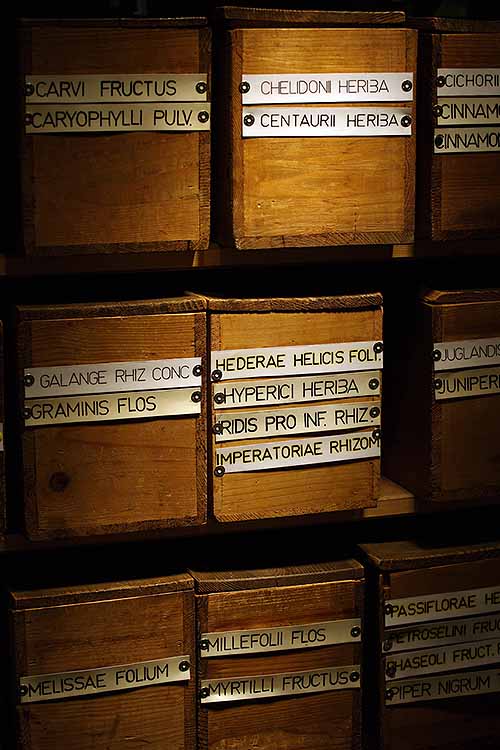
Cabinets Near Stoves or Ovens
These may absorb heat given off by stovetop cooking and baking, especially in the case of older model ovens.
Heat/AC Registers
These may cause temperature fluctuations as HVAC systems turn on and off.
Refrigerator Storage
Though it is cool and dark, the fridge is often too moist. And retrieval for use would mean taking your leaves from cold to warm with every use, which may degrade quality and flavor.
The best way to maintain a consistent temperature is to store in an airtight container in a cool, dark area. You’ll find some suitable products later in this post.
Why not create a separate drawer or rack for your collection?

A spice rack can do the job nicely, if you purchase smaller quantities (which is recommended, so you’ll use them more quickly when flavors are at their peak). Our review of some of our favorite spice racks can help to get you started.
3. Store Separately
Did you know that tea is a hygroscopic product? This means that it absorbs moisture and smells from the air around it. What does this mean for storage? Read on!
To keep your special blends tasting their finest, remember:
- Never store with other foods, particularly fragrant items like spices and coffee
- Don’t store near laundry detergents, powerfully scented dryer sheets, or other toxic cleaning agents
- Store different types separately, as they can absorb each other’s flavors
It would be very disappointing to have your high-quality second flush Darjeeling taste more like the BBQ-flavored potato chips you were storing nearby.
Dos and Don’ts
If you store your products well, they will last a long time. Lovers of the black types will be happy to hear that these sorts can be consumed over a 2-year period.
In contrast to that, green varieties have a shorter shelf life of only 6-8 months.
Matcha is even more sensitive, and should be used up in 3 months.
When you store in boxes or cans, don’t forget to print a label, or write a little note that contains information about the variety and the date of purchase. This way, you will know exactly which kind is in each container, and when you bought it.
My best advice is to consume products within a year, because their aroma and potential health benefits (especially of some of the green sorts) can deteriorate with time.
What else should you keep in mind, to get the best out of your favorite drink?
Do Don't Keep it cool (not cold) up to max. 68°F/20°C Expose to direct sunlight or heat sources Keep it sealed and airtight Expose to moisture Buy small amounts you can consume quickly Buy excess bulk or so many types that you can’t use up while they’re fresh
Store in Style
Are you with me so far? Great!
When choosing the perfect container, consider the following:
Does It Close with an Airtight Seal?
Keeping the dried leaves free of air and moisture will seal in its rich flavor and aroma.
Is It Convenient to Open and Close?
Airtight doesn’t mean Fort Knox. You’re going to want to get into this container often, so make sure it opens and closes with ease.
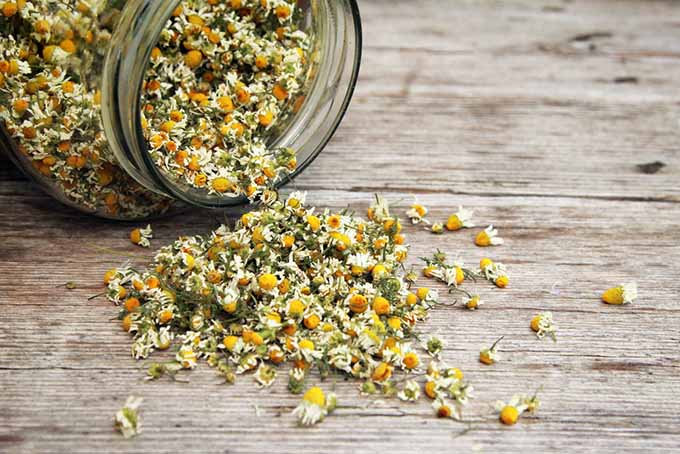
Is the Container Odor-Free?
If it’s new, make sure there is no offensive manufacturing odor, and no lingering food odors if used for other purposes in the past.
Let’s take a look at some possible storage solutions.
1. Metal: Tin, Aluminum, or Stainless Steel
If you’re like me, and you have a favorite variety that you enjoy drinking over and over, it’s useful to buy a decorative and functional tin box or caddy that you can refill again and again.
Did you know that storing tea in beautiful boxes and steeping its delicate aromatic leaves is an age-old tradition in cultures around the world?
The reason for storing in tin, aluminum, or stainless steel is that these materials are opaque and protect the contents from light, moisture, and odors.
Even traditional cookie tins make for great tea storage. Whether in bag form, or loose that you bag yourself with sandwich baggies, a roomy tin with a pretty picture, and a tight-fitting lid is a decorative, functional, and affordable option.
Make sure to buy products that can be closed properly. A screw cap works best.
Plus, a small viewing window on the boxes allows you to inspect the contents to see how much you have left, or if you’re having any issues with moisture, without needing to open the container.
2. Wood and Bamboo
Similar to ancient chests that stored precious leaves imported from the mysterious Orient, wood boxes make presenting tea to guests a celebration.
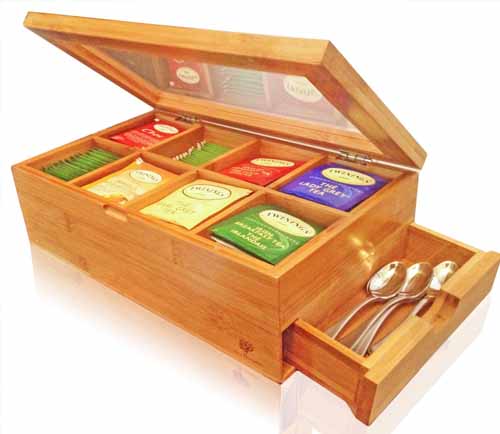
Bamboo Tea Box Natural Chest available on Amazon
Like in fine restaurants, the lid is opened before diners to reveal an array of tempting blends from which to choose.
Today’s versions often have clear lids and are best for storing bags enclosed in envelopes to preserve freshness.
Wood and bamboo vary in price from budget-friendly to expensive works of art to store and display your gourmet assortment.
3. Porcelain, Ceramic, and Glass
Containers made of these materials look classy, and have perfect qualities for ensuring freshness. They do not heat up or accumulate moisture.
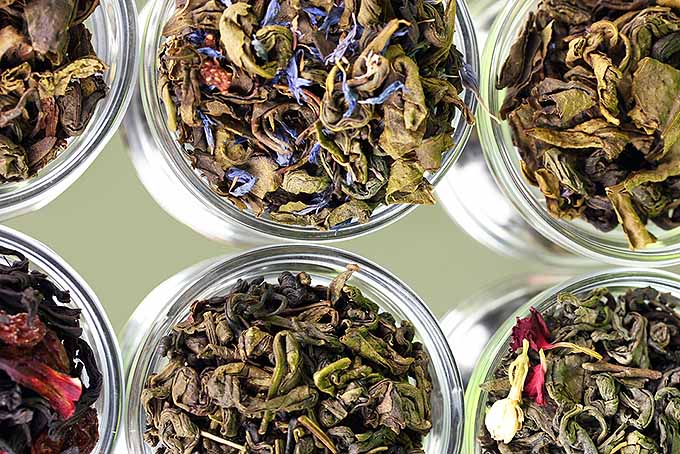
The only question you need to ask yourself is whether your box can be sealed correctly.
If you want to use your favorite ceramic jar that only has a simple lid, you could try double-packing. Use the packaging you bought your loose leaves came in, wrap it tightly, place it in the ceramic or porcelain jar, and seal with the lid.
Although glass is ideal when it comes to having no inherent odor, and being able to keep the contents free of unwanted smells, there is one problem – its transparency.
Priority Chef Set of 3 Glass Canisters in Silver Metal Overlay available on Amazon
If you choose this type, be especially careful to store it in a cool, dark place, away from direct sunlight.
There are a few glass options such as the set shown above that have metal overlays that help protect it from light.
4. Plastic Containers and Bags
While they’re not always the most decorative, plastic containers generally prove to be the most affordable storage option. Look for models that seal well and consider space-saving stacking styles.

Teavac 6-Ounce Vacuum Sealed Tea Storage Container available on Amazon
Storing in regular plastic bags is not recommended because they do not seal tightly enough.
Zipper bags may be a better solution than regular ones, but they, too, are not optimal for keeping the leaves and the flavor fresh.
Bonus Tip: Use zipper bags as extra packaging inside other containers, as described above for ceramic jars or porcelain. A little extra protection from the elements in your kitchen never hurts!
Organize Your Assortment
Bagged varieties are practical. With pre-measured packages, one is always handy for a quick cuppa, and the cost is relatively affordable.
On the downside, there’s quite a bit of packaging involved to create those little pouches of freshness.
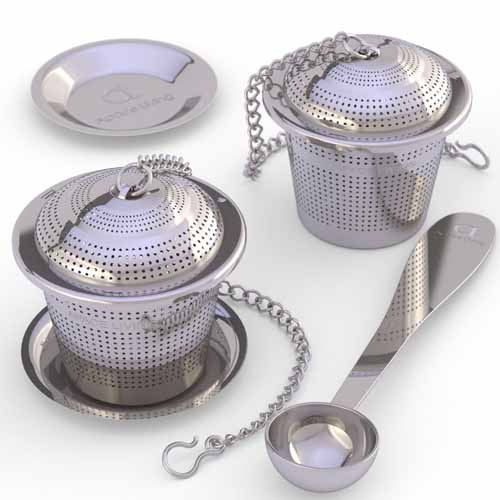
Loose Leaf Tea Infuser (Set of 2) with Tea Scoop and Drip Trays available on Amazon
If you prefer your beverage in bagged form, you’ll love some of the organizer boxes available to keep your favorites fresh and ready to present to your guests.
I sometimes use bagged varieties at home. But for my loose selections, I love to use small infusers for single cups that are often made of stainless steel and do not produce additional plastic waste.
5 Ways to Organize Your Collection
1. By Variety
The easiest way – especially when you’re a lover of lots of different kinds – is to arrange by type.
Depending on how many you have, you can create general or specific categories:
- Herbal
- White
- Green
- Black
- Oolong
- Rooibos
Also known as tisanes, strictly herbal types contain no actual tea leaves. These may be made from a single ingredient, like peppermint or chamomile, or may be comprised of blends of multiple herbs, fruits, and flowers.
White, green, black and oolong all come from the tea plant, but the processing that they go through differs in terms of age of the leaves when they are picked, drying length, and fermentation.
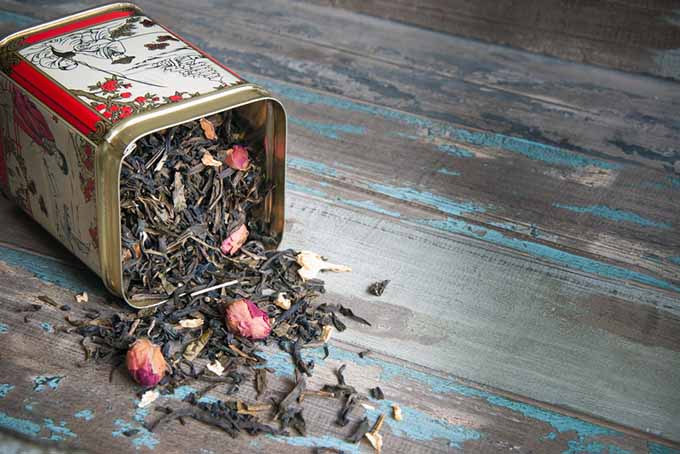
Regional provenance also plays a role, with further distinctions possible like Japanese or Chinese green tea, and Ceylon, Assam, or Darjeeling black tea.
Rooibos might technically fit in the herbal category, though it is sometimes referred to as a red tea. Rather than coming from the tea plant, this type is made from an infusion of the leaves of a South African shrub.
2. By Time of Day or Effect
Another way to arrange your collection is by preferred drinking time. There are various attributes you can focus on for this:
Distinguish Between Caffeinated and Caffeine-Free or Herbal
A useful distinction can be made between caffeinated and non-caffeinated.
If you respond strongly to this natural stimulant, you might want to consider this way of organizing your leaves so you don’t reach for the wrong one at 11:30 at night!
Relaxing vs. Invigorating Is About More Than Just Caffeine Content!
In addition, the differentiation between relaxing and invigorating brews can be helpful.
You can find herbal blends with calming ingredients like lavender and lemon balm, or refreshing varieties with lemongrass, mint, and other more intense herbs.
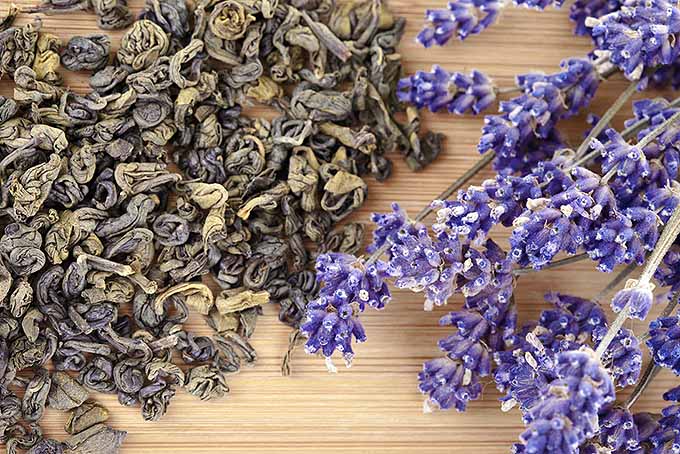
This can also be a good method for sorting black varieties of different strengths, like Darjeeling versus English Breakfast, and some green sorts as well.
Morning Pick-Me-Up or Afternoon Indulgence?
How about a “morning” “afternoon” or “evening” drawer, filled with your desired varieties for the specific time of the day?
A little box chest would serve nicely for this, or a set of canisters.
Healing blends can also be separated from everyday varieties in this way, with one drawer reserved for brews that are good for soothing a sore throat or a cough or helping you to get to sleep, and another where you stock your caffeine-rich blends and dessert varieties.
3. By Separating Plain Types from Those with Added Flavors
My current collection contains lots of all-natural kinds, but also some loose types that are infused with naturally derived flavors and aromas like vanilla or cinnamon.
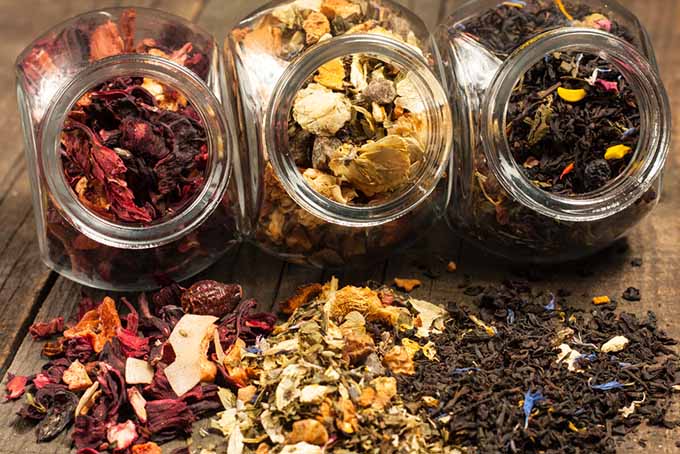
Whenever one of my friends who avoids drinking flavored varieties comes over, I know exactly where to find the perfect type.
Arranging your assortment in this way is not only helpful for sensitive drinkers, but also if you tend to gravitate towards purchasing many different flavored varieties.
Flavoring isn’t just for black teas – you’ll find it in white, green, rooibos, and herbal sorts as well.
Arrange them in similar aroma groups, and you’ll be able to find whatever you’re craving easily.
4. By Scent or Flavor
Similar to the method outlined above, and the last item of sorting suggestion #2, you can organize your assortment according to their most prominent flavor notes, and varying strengths.
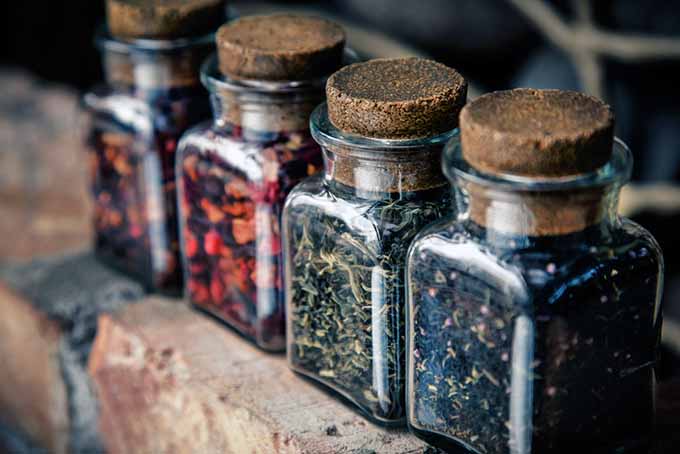
You might think it’s obvious that fruit types taste different from black varieties, but there’s still a way to sort them into various subcategories so you’ll easily be able to locate exactly what you’re in the mood for.
Are you a lover of black varieties and like to keep several on hand? Why not arrange them according to their unique flavor profiles into categories from floral to malty, or mild to strong?
Like a good beer or wine, there’s a lot to be explored in the unique taste in a fresh brewed cuppa.
Fruit and herbal blends may be treated similarly. You may have sweet versions, but also more tangy, bitter, or mild ones.
Arranging your containers this way is similar to organizing them by time of day and physical effects, but using this method, you can still subdivide each sort individually.
5. By Date
It’s also possible to sort your collection by purchase date.
This is useful when you have lots of different sorts and you don’t care so much about what type you drink, but rather want to consume whichever is the oldest or that is already opened.
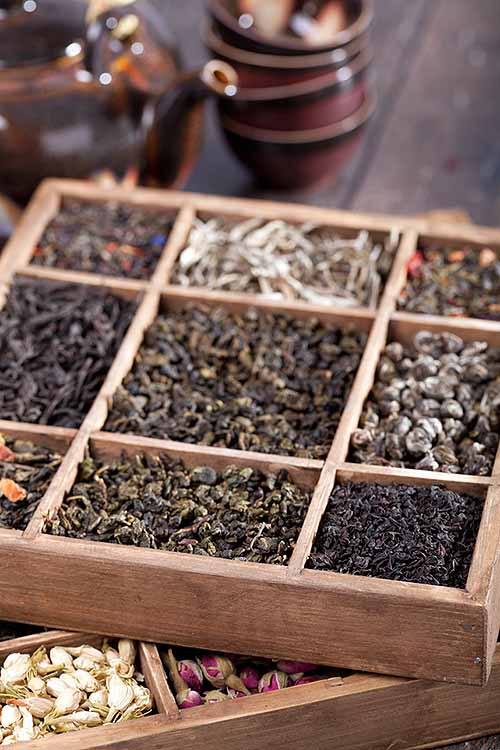
Noting the purchase date as well as the date of manufacture when available is always useful. This is really a good idea for people who don’t drink tea daily, but who want to make sure the leaves don’t age and lose their flavor prematurely.
Store new purchases at the back of your shelf or cabinet, and follow the First In First Out (FIFO) method when you select a sachet or a measure of leaves for your next mug.
How About a Nice Hot Cup?
Are you a passionate tea drinker? Do you prefer bags, or the loose varieties?
Either way, proper storage, according to whatever organizational system meshes well with your own unique style, will help to take your enjoyment of this classic and international beverage to the next level.
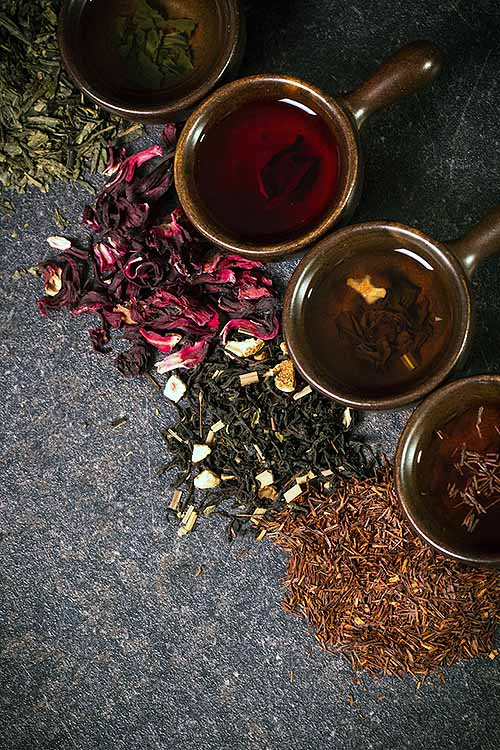
It’s time to take the hassle out of preparing a nice cup of tea, at any time of day, no matter what you’re in the mood for.
Get your stash out of the closet, ditch the old stuff, and choose a cabinet, spice rack, storage box, or set of canisters that works for you and your space. You’ll be richly rewarded!
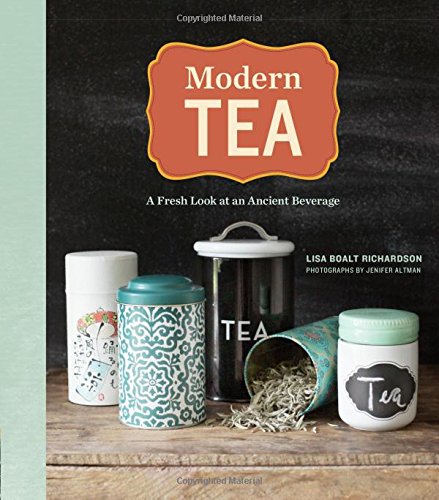
Modern Tea: A Fresh Look at an Ancient Beverage available on Amazon
If you’re interested in learning more, pick up a copy of Modern Tea: A Fresh Look at an Ancient Beverage by Lisa Boalt Richardson.
Have you come across any problems with keeping leaves fresh and flavorful?
How have you have organized your tea shelf or drawer? How many varieties do you have, and have you ever thought about arranging them in a special way?
Tell me what you like to drink and how you store your favorites in the comments!
Photo credits: Shutterstock. With additional writing and editing by Nan Schiller and Allison Sidhu.
About Nina-Kristin Isensee
Nina lives in Iserlohn, Germany and holds an MA in Art History (Medieval and Renaissance Studies). She is currently working as a freelance writer in various fields. She enjoys travel, photography, cooking, and baking. Nina tries to cook from scratch every day when she has the time and enjoys trying out new spices and ingredients, as well as surprising her family with new cake creations.


In researching storage of teas, I found your article to be helpful. Thank you for a simple layout, full of good information and great pictures.
Useful and clearly written article with beautiful photography.
Thank you! ????
Fabulous amount of information and loved the photos.
I have two beautiful tins for my Earl grey and Lady grey leaf tea,
but have been looking for the perfect tin for my rooibos bagged tea.
Thank you again for the comprehensive information.
S Juniper